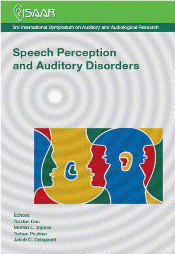On the relationship between multi-channel envelope and temporal fine structure
Resumé
The envelope of a signal is broadly defined as the slow changes in time of the signal, where as the temporal fine structure (TFS) are the fast changes in time, i.e. the carrier wave(s) of the signal. The focus of this paper is on envelope and TFS in multi-channel systems. We discuss the difference between a linear and a non-linear model of information-extraction from the envelope, and show that using a non-linear method for information-extraction, it is possible to obtain almost all information about the originating signal. This is shown mathematically and numerically for different kinds of systems providing an increasingly better approximation to the auditory system. A corollary from these results is that it is not possible to generate a test signal containing contradictory information in its multi-channel envelope and TFS.
Referencer
Bargmann, V. (1961). “On a Hilbert space of analytic functions and an associated integral transform”, Commun. Pure Appl. Math. 14, 187–214.
Chassande-Mottin, E., Daubechies, I., Auger, F., and Flandrin, P. (1997). “Differential reassignment”, IEEE Sig. Proc. Letters 4, 293–294.
Dau, T., Püschel, D., and Kohlrausch, A. (1996a). “A quantitative model of the effec- tive signal processing in the auditory system. I. Model structure”, The Journal of the Acoustical Society of America 99, 3615–3622.
Dau, T., Püschel, D., and Kohlrausch, A. (1996b). “A quantitative model of the "ef- fective" signal processing in the auditory system. II. Simulations and measure- ments”, The Journal of the Acoustical Society of America 99, 3623.
Decorsière, R., Søndergaard, P. L., Buchholz, J., and Dau, T. (2011). “Modulation Filtering using an Optimization Approach to Spectrogram Reconstruction”, in Proceedings of Forum Acusticum (EAA).
Drullman, R., Festen, J., and Plomp, R. (1994). “Effect of temporal envelope smear- ing on speech reception”, The Journal of the Acoustical Society of America 95, 1053–1064.
Flanagan, J. L. and Golden, R. M. (1966). “Phase vocoder”, Bell System Technical Journal 45, 1493–1509.
Gabor, D. (1946). “Theory of communication”, J. IEE 93, 429–457.
Ghitza, O. (2001). “On the upper cutoff frequency of the auditory critical-band enve- lope detectors in the context of speech perception”, The Journal of the Acoustical Society of America 110, 1628.
Glasberg, B. and Moore, B. C. J. (1990). “Derivation of auditory filter shapes from notched-noise data.”, Hearing Research 47, 103.
Griffin, D. and Lim, J. (1984). “Signal estimation from modified short-time Fourier transform”, IEEE Trans. Acoust. Speech Signal Process. 32, 236–243.
Slaney, M., Inc, I., and Alto, P. (1995). “Pattern playback from 1950 to 1995”, in IEEE International Conference on Systems, Man and Cybernetics, 1995. Intelligent Systems for the 21st Century., volume 4.
Smith, Z., Delgutte, B., and Oxenham, A. (2002). “Chimaeric sounds reveal di- chotomies in auditory perception”, Nature 416, 87.
Søndergaard, P. L., Culling, J. F., Dau, T., Goff, N. L., Jepsen, M. L., Majdak, P., and Wierstorf, H. (2011a). “Towards a binaural modelling toolbox”, in Proceedings of the Forum Acousticum 2011.
Søndergaard, P. L., Torrésani, B., and Balazs, P. (2011b). “The Linear Time Frequency Analysis Toolbox”, International Journal of Wavelets, Multiresolution Analysis and Information Processing. Accepted for publication.
Yderligere filer
Publiceret
Citation/Eksport
Nummer
Sektion
Licens
Authors who publish with this journal agree to the following terms:
a. Authors retain copyright* and grant the journal right of first publication with the work simultaneously licensed under a Creative Commons Attribution License that allows others to share the work with an acknowledgement of the work's authorship and initial publication in this journal.
b. Authors are able to enter into separate, additional contractual arrangements for the non-exclusive distribution of the journal's published version of the work (e.g., post it to an institutional repository or publish it in a book), with an acknowledgement of its initial publication in this journal.
c. Authors are permitted and encouraged to post their work online (e.g., in institutional repositories or on their website) prior to and during the submission process, as it can lead to productive exchanges, as well as earlier and greater citation of published work (See The Effect of Open Access).
*From the 2017 issue onward. The Danavox Jubilee Foundation owns the copyright of all articles published in the 1969-2015 issues. However, authors are still allowed to share the work with an acknowledgement of the work's authorship and initial publication in this journal.


